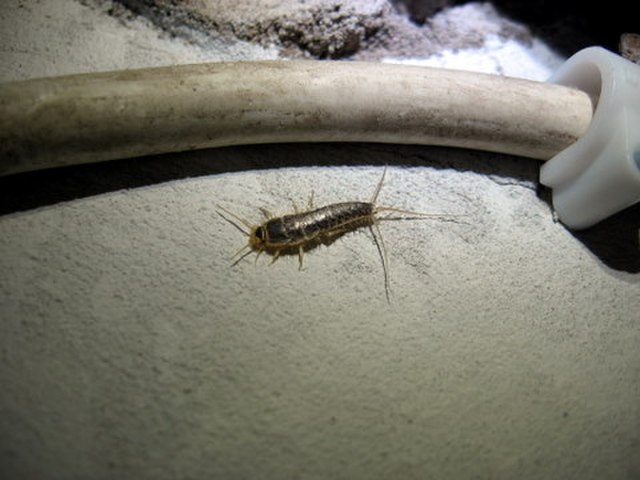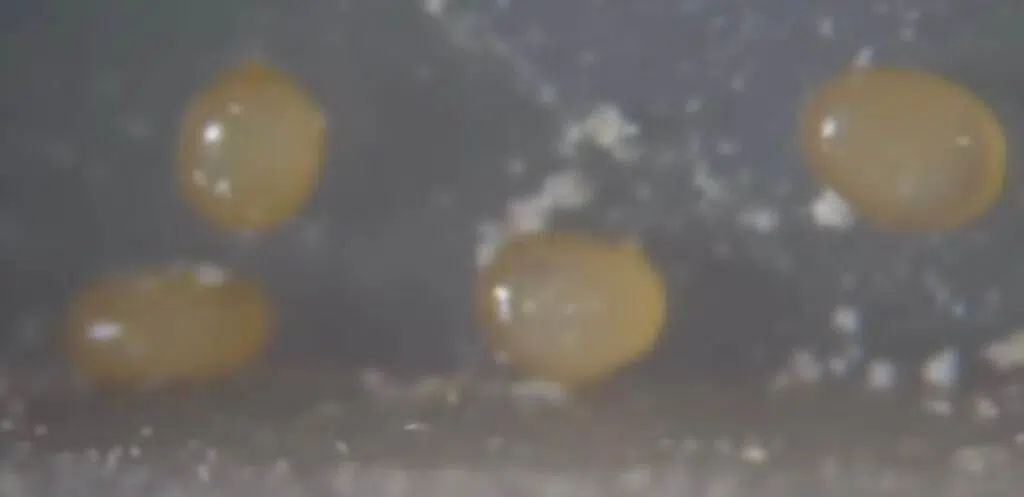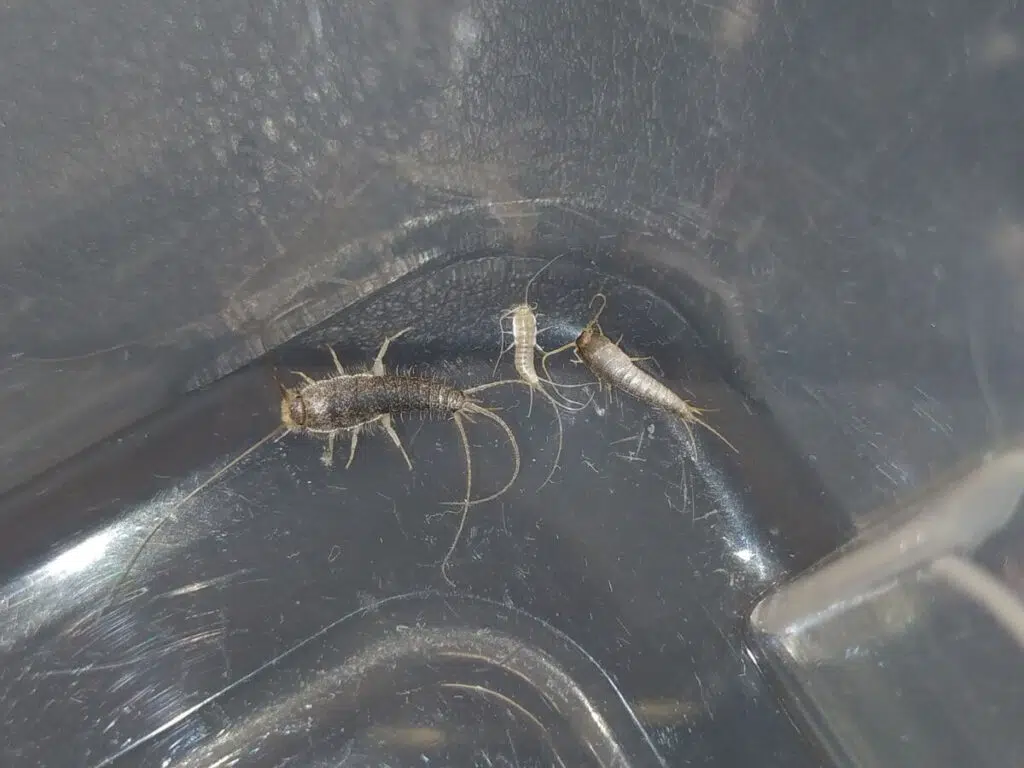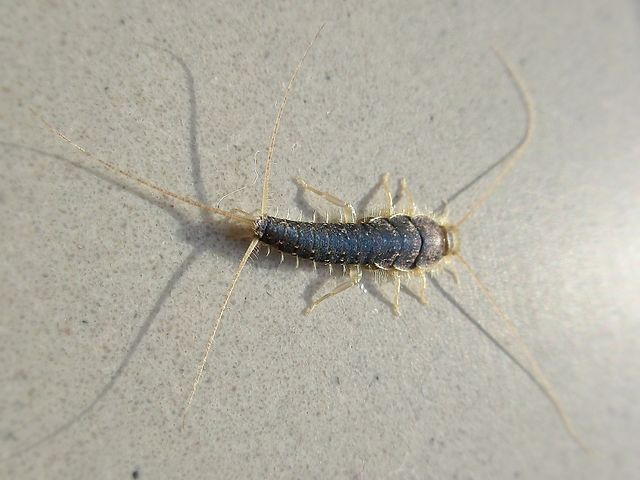Eliminating silverfish from the bathroom is not easy. This is an environment silverfish love due to its warmth and high humidity.
Silverfish are a minor home pest. They can still cause damage around the house. Silverfish eat through clothes and towels in the bathroom. They also chew toilet paper, wallpaper, and carpets around the bathroom.
Eliminating them as soon as possible is recommended. Chemicals and natural repellents are successfully used to keep silverfish away.
Table of Contents
What are silverfish?
Silverfish are small insects that grow to a size between 13 and 25mm. Similar to fish in their appearance, these insects have a wider body towards the head and the narrower body towards the abdomen.
Silverfish are known for their gray metallic coloring. While this makes them stand out, they might not easily be seen during the day as silverfish are nocturnal insects.

Are silverfish in the bathroom dangerous?
Silverfish don’t bite and they don’t carry disease. There are no reported cases of silverfish biting people as these insects have very strict preferences in terms of food.
While silverfish don’t bite, these insects can still be irritating. They can multiply quickly in bathrooms.
Silverfish can lay eggs all around the house as soon as they reach adulthood. Some of the places they lay eggs can be difficult to find as silverfish prefer crevices.
Why do Silverfish Live in the Bathroom?
Silverfish like humidity in the bathroom. They are only found in high moisture areas which means they favor bathrooms over all other rooms in the house.
Moisture
Silverfish are mostly found in the bathroom as this is where the highest humidity levels are recorded in the house.
Studies show silverfish thrive in humidity levels of at least 75%. This is a humidity level achieved in bathrooms after taking a bath or a shower.
The relative humidity that these insects love can be as high as 95%. This is why they are common in public baths, basements, and all other areas with poor or no ventilation that traps moisture such as city sewers.
Food
Cellulose is one of the biggest reasons silverfish are found indoors. They are among the insects that can digest cellulose and starches.
This means silverfish eat and damage carpets, towels, books, magazines, toilet paper, plaster, wallpaper
Silverfish can also eat cotton, linen, and silk. All of these objects and materials are found in bathrooms.
Laying eggs
Silverfish like to lay eggs in safe moist places. Their eggs are very small and sometimes not immediately visible.
But silverfish find the best place to lay eggs is the safest area they live in the house, which is the bathroom.

Signs of a Silverfish Infestation in the Bathroom
Before you proceed with getting rid of silverfish in the bathroom you need to be sure there’s an actual infestation.
Unfortunately, signs of an infestation can be as simple as seeing a single silverfish.
Seeing one or multiple silverfish
Seeing a single silverfish in the bathroom is problematic as others might be in there as well. These insects are very good at hiding during the day.
They might hide under the bathtub or behind the toilet. But seeing a single silverfish should prompt house residents to do a thorough checkup to see if there are more silverfish around.

Pro tip: always check for silverfish infestations at night. You can turn on the bathroom light to surprise possible insects in the bathrooms that aren’t hiding as silverfish are nocturnal and highly active only at night.
Silverfish droppings
Silverfish droppings look similar to peppercorns. You cannot overlook them on the tile or the bathroom floor.
If you see these types of droppings you need to act quickly.
Silverfish droppings can attract other silverfish or other bugs such as American cockroaches.
Pro tip: It’s best to deep clean the bathroom while also checking for silverfish if you see silverfish droppings.
Damaged goods around the bathroom
While silverfish are a nuisance pest, they can still damage almost all objects and surfaces in the bathroom.
Checking for early signs is best to limit the damage and to limit infestation.
You can start by checking all goods in the bathroom that contain cellulose. This includes newspapers, magazines, and toilet paper.

One of the easiest foods for silverfish is toilet paper due to its soft texture. Holes or chewed areas of toilet paper indicate a possible silverfish infestation.
Cotton and linen are also seen as chewable materials by silverfish. Make sure to check bathroom towels for possible damages.
Wallpaper can also be chewed for its cellulose content by silverfish. It’s best to check areas around the floor as this is where silverfish have easy access.
Yellow marks around the bathroom
Yellow marks are typical for areas with a silverfish infestation. Some yellow marks might be confused with light color brown marks, specific to cockroaches. Whatever the pest that lives marks is, you know that you need to deal with the infestation immediately.
Skin molt
Silverfish are known to live up to 3 years. This lifespan is marked by multiple molts.
Up to 60 molts are common for silverfish. You can check for molt signs such as a transparent outer shell around the bathroom.
The shape of this shell should be similar to the shape of silverfish in the case of a recent molt or flattened whenever you’ve already stepped on it.
Multiple molting signs indicate a nest and an infestation.
Wallpaper cracks
Many believe silverfish eat wallpaper. This is true for wallpaper that contains cellulose.
Silverfish can also make holes through wallpaper to reach plaster which it also eats.
You can check for all types of wallpaper damage around the bathroom to determine a possible silverfish infestation.
Types of Silverfish Live in the Bathroom?
While most species of silverfish look similar many are different. They differ in how they look and where they live.
1. Common silverfish

Common in North America, the Common silverfish (Lepisma saccharina) is identified by a richer silver color.
This silverfish species is known to have adapted to colder climates. This is why the Common silverfish might be seen in bathrooms across Northern states.
2. Four-lined silverfish

The Four-lined silverfish (Ctenolepisma lineatum) gets its name from the stripes that run along its body.
Four-lined silverfish aren’t that common in Northern states as they prefer warm climates. They can be found in bathrooms of Southern states.
3. Giant silverfish

The giant silverfish (Ctenolepisma longicaudata) is also known as the Gray silverfish. This species can be light gray or dark gray.
A common type of Giant silverfish in warm climates is dark gray, almost black.
This species is likely confused with other insects when seen in bathrooms due to its dark coloring.
Where do Silverfish in the Bathroom Hide?
Silverfish aren’t always visible around the bathroom. This is by far the biggest problem of a silverfish infestation.
Not having the possibility of seeing the insects around might make house residents think these insects aren’t there. Here’s where to look.
Cracks in walls

Silverfish are excellent at hiding in cracks and small openings. Make sure to check the space in the wall and around the bathroom window.
Other places where cracks in walls might exist and not be noticed include the walls behind the toilet and the wall below the sink where water leaks might crack walls over the years.
Under tile
Tile that isn’t properly installed offers a high moisture dark place for silverfish to crawl under. It’s best to check bathroom flooring as silverfish can hide in their hundreds under the visible portion of the floor.
Under the bathtub
If every floor and every wall is properly sealed silverfish will move to take shelter under the bathtub. This is easy for them as the place has no natural light and as nocturnal creatures silverfish are known to appreciate dark spots.
Silverfish might also be deeper in wall cracks under the bathtub. You can use a flashlight to check the area properly.
11 Methods to Get Rid of Silverfish in the Bathroom
There are many chemical-based and natural-based methods of keeping silverfish out of the bathroom.
It can take up to a few days to completely remove these insects from your bathroom and the methods to achieve this task can be complex.
1. Consider sticky traps
Using sticking traps is the cheapest method of getting rid of silverfish in the bathroom. These traps use sticky cardboard to trap the insects.
Sticky traps are placed just about anywhere around the bathroom, but preferably in shaded areas such as under bathtubs as this is where most silverfish hide.
Sticky traps might also need to be replaced in case of serious infestations.
Pro tip: try replacing the sticky trap every day if you see silverfish getting caught up on it for higher success rates.
2. Use an old newspaper to trap silverfish
The old newspaper method works with silverfish.
While you can use new newspapers, old paper is softer and more attractive to insects.
The newspaper is rolled so that silverfish can crawl inside. They will spend days eating the paper rich in cellulose.
Once you see a few silverfish inside the newspaper you can remove them using a garbage plastic bag.
Pro tip: roll up a few old newspapers and place them in dry areas of the bathroom such as under the sink or behind the toilet. Don’t forget to check for silverfish every day.
3. Use bleach
Bleach is sometimes poured directly on silverfish to kill them on the spot. This effective method has been tried and tested on almost all types of insects found inside the house.
The limitation of this method is the possible health implications. Inhaling bleach fumes and pouring it around the bathroom isn’t the healthiest method of getting rid of silverfish for your family.
Pro tip: always wear gloves and a protective breathing mask when handling bleach. Make sure to clean and ventilate the bathroom up to a few days after killing silverfish.
4. Use boric acid
Boric acid works similarly to bleach. This solution is one of the most recommended when it comes to dealing with a serious infestation.
It can take a while for boric acid to work as silverfish might be deterred by it and remain in hiding for up to a few days.
As with bleach, this solution isn’t recommended for families with pets or children.
Pro tip: sprinkle boric acid (while wearing gloves) in the corners of your bathroom and under bathroom furniture.
5. Spray essential oils
Essential oils are among the natural silverfish repellents. These can be used successfully both to deter and eliminate silverfish from the bathroom.
One of the main benefits of using essential oil is the nice-smelling bathroom that results after weekly application.
The downside is that essential oils are expensive and they need re-application for the best result.
Cedarwood is one of the ingredients that best works against silverfish. Cedar oil has been used against a wide range of insects and bugs such as silverfish and carpet beetles for years.
This type of essential oil is mixed with water and sprayed on floors and walls in the bathroom.
Pro tip: mix 5-10 drops of cedar essential oil with 2.5 ounces of water for a potent solution to spray in bathroom corners, around the sink, and around the toilet.
6. Consider spreading cloves and bay leaves around the bathroom
Cloves are known for their high eugenol content. Eugenol deters silverfish through its potent odor.
Dry cloves can be sprinkled in small batches in key areas around the bathroom. This includes the area around the sink and the area around the shower.
Cloves have no side effects and they also make your bathroom smell nice.
The downside in case of serious infestations is that cloves alone might not deter hundreds of silverfish.
Pro tip: sprinkle dry cloves in dark areas around the bathroom such as under bathtubs.
7. Sweep and vacuum
Vacuuming is one of the quickest and cheapest methods of eliminating silverfish in the bathroom. For the best result, you need to close the door behind you so that the insects don’t escape.
A powerful vacuum cleaner can efficiently catch silverfish under furniture, and the bathtubs and even draw them out of cracks and crevices.
Frequent vacuuming even after silverfish is gone is going to help clear out any leftover eggs as well.
Pro tip: make sure to vacuum all areas of the bathroom including tight spaces behind the furniture to catch all silverfish.
8. Sprinkle Epsom salt around the bathroom
Epsom salt is a natural insecticide used against silverfish. They are likely going to eat this salt if you sprinkle it on a newspaper they eat for cellulose.
Epsom salt dehydrates silverfish and it can kill the insects in a matter of hours.
This natural insecticide is different from table salt which does not affect silverfish.
Pro tip: always sprinkle Epsom salt on paper or on a piece of cotton clothing to act as bait for silverfish.
9. Use Diatomaceous Earth
Diatomaceous Earth is a type of natural salt. You can sprinkle it in the most important areas of the bathroom such as under the sink.
This type of salt acts similarly to Epsom salt as it kills silverfish.
Pro tip: sprinkle large quantities of Diatomaceous Earth under bathtubs so that silverfish have no option but to move through it and dehydrate. Vacuum it up after the insects are dead.
10. Use dry bay leaves
Bay leaves have been shown to have a pungent odor silverfish love. The good news is dry bay leaves should already be in the kitchen.
This solution is safer than using Epsom salt, especially for homes with pets. Make sure to add more bay leaves than you think is necessary to create a strong pungent odor in the bathroom.
Pro tip: place dry bay leaves in the bathroom both on the floor and higher up such as on the sink to deter silverfish.
11. Use cinnamon
Cinnamon has a similar deterring effect on silverfish to bay leaves. You might already have it in the kitchen so you can use it in the bathroom to make it smell good and keep silverfish away.
Pro tip: use a combination of ground cinnamon and whole cinnamon sticks around the bathroom to make cinnamon smell dominating and to keep silverfish and other insects out of the bathroom.
How to Prevent Silverfish in The Bathroom
Once you’ve eliminated all silverfish you still need to ensure they don’t return. There are high chances of silverfish returning to your bathroom in the future unless you take preventive measures.
Invest in a dehumidifier
Excessive humidity is one of the major reasons silverfish move in the bathroom. It might take a while to dehumidify the bathroom but it’s a task that needs to be done to eliminate these pests.
Set the dehumidifier to humidity levels lower than 60% in the bathroom so that you control excessive humidity without reducing air quality too much.
Fix leaky pipes
Leaky pipes play a crucial role in high bathroom humidity. All leaks need to be fixed to avoid property damage as well as to keep silverfish out.
A plumber can find and fix all leaky pipes in the bathroom. Clogged drains also need to be cleared for a normal water flow.
Always vacuum the bathroom
Vacuuming is known to be the simplest routine task to quickly eliminate silverfish. It’s always best to use a powerful vacuum cleaner as silverfish might hide in cracks and crevices.
You need to vacuum the bathroom multiple times per day if a silverfish infestation is confirmed. Otherwise, vacuuming the bathroom at least once per week is recommended to keep all types of pests out.
Consider adding a permanent trap under the bathtub
A permanent trap is recommended in homes exposed to higher risks of pest infestation. These might be old homes where high humidity is prevalent.
Sticky traps are some of the most affordable eco-friendly silverfish traps. They can be placed under the bathtub or in other dark areas of the bathroom.
Remove clothes from the bathroom
Clothes attract silverfish. Cotton is among the fabrics where silverfish are found as they eat through it. Removing damp clothes and towels is recommended.
You need to only keep dry clean towels in the bathroom. Damp towels attract silverfish and they increase humidity in the bathroom.
Seal all cracks
Cracks in walls and floors are known to be silverfish hiding places. They need to be sealed so that pests don’t nest or hide in them.
A multi-surface waterproof sealant is recommended for all cracks in the bathroom. This is the only type of sealant that resist high humidity.
Remove foods silverfish like
Silverfish might also be attracted to food around the house. All foods should be kept in sealed containers so they don’t attract pests.
Store all foods in plastic containers, especially if the bathroom is close to the kitchen.
Improve ventilation
Poor ventilation in the bathroom is one of the main reasons for a silverfish invasion. Even a dehumidifier cannot balance out poor ventilation.
Consider adding a window to your bathroom or updating the old small window to a larger window for better ventilation. Always let fresh air in after taking a bath or a shower.
FAQ
Silverfish can’t bite people. Often mistaken for dangerous pests, silverfish prefer to flee when they see people. They hide away to avoid confrontation.
While called silverfish, these small elongated insects cannot swim. Many believe they can swim because silverfish are attracted to high moisture and water leaks.
Silverfish can climb certain rough surface walls, especially wood walls when crawling indoors. Silverfish have a difficult time climbing smooth surface walls inside the house.
Silverfish are known to jump. They can jump a few times their body size which helps them move quicker. Silverfish can jump up to 2 feet in the air.
Silverfish aren’t attracted to clothes but to the starches in clothes. They might feed on certain clothes such as damp cotton clothes for their higher starch content.
Table salt doesn’t kill silverfish. It would have to be ingested in very large quantities for silverfish to die. However, Epsom salt is a natural pest-repelling salt known to kill silverfish.
Only washing clothes at high temperature is recommended to kill silverfish and silverfish eggs. Cotton and other types of fabrics aren’t recommended for washing at high temperatures and as a result, silverfish should be removed from clothes using different methods.
Bleach kills silverfish and silverfish eggs. You can pour bleach directly on silverfish to kill them on the spot. Make sure to take the right protective measures such as wearing a mask to avoid inhaling toxic bleach fumes.
Borax is known to kill silverfish. It has a sweet taste which attracts silverfish to it. When used over long periods borax also kills silverfish eggs diminishing silverfish infestations considerably.
Vinegar has a limited effect on silverfish. It can’t kill silverfish on its own which is why it shouldn’t be seen as the first option to keep these insects out of the house.
Baking soda can attract silverfish if placed in a tall pot these insects can’t escape from. Baking soda is typically mixed with sweet honey and water to lure silverfish to a large pot they can’t escape from before drowning.
Raid is known to kill silverfish. You need to spray it directly on the insects for them to be killed on the spot.
Diatomaceous earth kills silverfish. This powder is known to eat through the outer coating of silverfish and their eggs. It eventually kills all silverfish when sprinkled around the house.
Fumigation can kill silverfish. This is a method used by pest control companies on other more dangerous pests such as termites but it can be successfully applied against silverfish.
Very high heat and direct sunlight exposure kill silverfish which need moisture. However, high heat rarely kills silverfish inside the house where they can crawl into a dark humid place to safety.
Lysol is a type of pest spray made for multiple types of home pests. It kills silverfish but only when sprayed directly. Lysol doesn’t kill silverfish when sprayed sporadically in a room.
Zevo uses essential oils to kill pests. Zevo products can successfully be used to kill silverfish and silverfish eggs.
Mothballs do not kill silverfish. The toxic fumes of mothballs are known to act as a deterrent or an invisible barrier that keeps silverfish out of a room or the area of room mothballs are found.
Summary
Silverfish have many reasons to be in the bathroom. Unlike cockroaches, they might eat other things apart from food such as toilet paper and magazines for their cellulose content. As a result, silverfish don’t need to be in the kitchen to thrive.
Initially attracted to high humidity, silverfish can nest and live in bathrooms where they have access to cellulose-rich goods. Silverfish can be removed from bathrooms with chemical solutions such as bleach. They can be manually removed with a vacuum cleaner as well.
Natural silverfish repellents such as essential oils and cinnamon sticks also help drive the insects out of the bathroom.
Further Reading:

